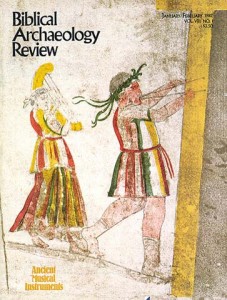Biblical Archaeology Review, January/February 1982
Special Section
Introduction
Ancient musical instruments is the theme—with variations—of this special section. Even before people invented writing they used music to accompany their ceremonies and the express their feelings. More than 5,000 years ago, someone walking through a courtyard in Megiddo paused to scratch a drawing in the stone...Read more ›
The Finds That Could Not Be
Archaeologists are gradually recovering the remains of musical life from ancient Israel. More than three hundred remains of actual instruments and representations of musical scenes have been recorded. The dates of these items range from late pre-history to the Byzantine period, including a sizable number within the...Read more ›
How Scholarly Communication Works
A bone flute discovered in the City of David leads to another and elucidates a Talmudic passage
A cow’s foreleg with six holes was illustrated in color in “Digging in the City of David,” BAR 05:04. Archaeologists identified the perforated bone as a flute; by blowing into the hollow bone and covering different holes, different notes could be produced. The bone flute, recovered from...Read more ›
“Sounding Brass” and Hellenistic Technology
Ancient acoustical device clarifies Paul’s well-known metaphor
No New Testament passage is better known than Chapter 13 of Paul’s first letter to the Corinthians. Its singular lyrical felicity and its insistence upon love differentiates it from the often practical and pragmatic side of Paul’s mind. This ode to love begins (in...Read more ›
Features
What Did David’s Lyre Look Like?
A delicate jasper seal may tell us
“The spirit of Yahweh had forsaken Saul, and at times an evil spirit from Yahweh would seize him suddenly. His servants said to him, ‘You see, sir, how an evil spirit from God seizes you; why do you not command your servants here to go and find...Read more ›
BAR Jr.: Digging, Dug, Gone
Many people do not realize that archaeology is destructive. Unlike experiments in physics or chemistry, which can be repeated in the lab, once a site has been excavated it cannot be re-excavated. The archaeological remains are gone forever from their position in the earth. Therefore, the key...Read more ›
The Volunteer’s Contribution to Archaeology and Vice Versa
Except in Woody Allen movies, there are no “man-in-the-street” brain surgeons. No journal that I know of invites its readers to spend two weeks as volunteer atomic physicists. It’s different with archaeology. From the very beginning, the amateur was a key figure. Heinrich Schleimann, who revealed the...Read more ›
Excavation Opportunities 1982
Diving to recover Herodian columns from Caesarea’s harbor, breaking ground at a new dig in Jordan, restoring a Middle Bronze (22nd–16th century B.C.) “mansion” in the Sharon Plain—these are a few of the excavation opportunities for volunteers in 1982. A dig provides the chance to live with...Read more ›
Ebla Scholarship à la Syrienne
BAR reports on Damascus symposium
How the ancient history of Syria was “faked” was the subject of a recent symposium held in Damascus. The following article is based on an account of the symposium in the English-language Syria Times. The Damascus symposium focused principally on the cuneiform archive found at Ebla in...Read more ›

